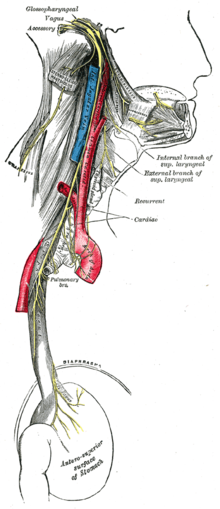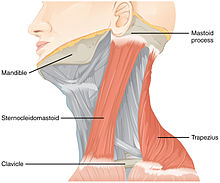Accessory nerve
The paired accessorius nerve [Willisii] ( Latin accessorius , “additional nerve”; occasionally with the addition Willisii , the genitive of the Latinized name of its first description Thomas Willis ) carries motor nerve fibers and is commonly referred to as the eleventh cranial nerve , N. XI , called the tetrapod .
However, it consists of a cranial part and a spinal part, which arise with separate roots ( radices ), temporarily form a short trunk ( truncus ) together, and divide again into two branches ( rami ).
- The fibers of the cranial part originate from the nerve cell bodies of the nucleus ambiguus in the medullary brain at the floor of the lozenge fossa , emerge as radices craniales in the caudal continuation of the root fibers of the nervus vagus from the elongated marrow , and after exiting the skull are supplied to the vagus nerve as the internal ramus . They represent the caudal continuation of the vagus and innervate the branchiomeric muscles of the throat and larynx .
- The fibers of the spinal part originate from nerve cell bodies of the nucleus nervi accessorii in the anterior horn of segments C1 to C6 of the cervical cord , emerge as radices spinales between the anterior and posterior root fibers of the spinal nerves from the spinal cord , first run into the skull and , when they exit again, form the ramus externus , from which muscle branches branch off. They innervate the sternocleidomastoid muscle and the trapezius muscle and can be viewed as a spinal nerve.

Radix spinalis or pars spinalis
The radices spinales (" roots of the spinal cord") originate from the upper neck segments of the spinal cord . However, they emerge from the spinal cord in the lateral area and not via its anterior radix . The fibers have their origin in a collection of motor neurons , which are referred to as the nucleus nervi accessorii or also nucleus principalis nervi accessorii . The nerve fibers rise next to the spinal cord in the subarachnoid space and run through the foramen magnum into the posterior fossa . This fiber portion forms the pars spinalis of the accessory nerve.
Radix cranialis or pars vagalis
The radices craniales ("skull roots") emerge from the medulla oblongata below the roots of the vagus nerve in the posterolateral sulcus . They lead ( branchio ) motor fibers, such as the cranial nervus glossopharyngeus (N. IX) and nervus vagus (N. X), from the nucleus ambiguus . This fiber portion forms the pars vagalis of the accessory nerve. Whether it should actually be assigned to the vagus nerve is still controversial.
Course and function
The two root portions unite in the cranial cavity for celiac nerve accessorii , draw a short distance next to each other in common Epineurium , and leave the skull through the jugular foramen , pars intermedia, accompanied by the vagus nerve (through the foramen attracts also the glossopharyngeal , is however, separated by a dura mater bridge, in its own compartment). Usually when it passes through the jugular foramen, the accessory nerve divides into two branches
- As the ramus internus, the “branchiomotor” fibers of the radix cranialis or pars vagalis are transferred to the nervus vagus, which receives them between the ganglion superius [jugulare] and ganglion inferius [nodosum]. Together with some vagus fibers from the nucleus ambiguus, these fibers form the nervus laryngeus recurrens - as the nervus of the sixth branchial arch - the terminal branch of which the nervus laryngeus inferior (or caudalis in animals) supplies the lower pharyngeal constrictor and the internal larynx muscles.

- as the external branch moves the fiber portion of the spinal radix or pars spinalis , crossing the internal jugular vein to the sternocleidomastoid muscle and the trapezius muscle . The branch, lying above the levator scapulae muscle , descends diagonally through the lateral triangle of the neck , connects with branches of the cervical plexus , and reaches the trapezius muscle from below. Via this and independent rami musculares from the cervical plexus, sensitive, proprioceptive fibers (for muscle spindles and Golgi tendon organs ) also reach the two muscles.
Fish do not yet have these nerves distinctly because they do not have a neck, but they do have the fibers to certain spinal muscles of the head.
When Jackson syndrome (cranial nerve syndrome) leads to lesions of the accessory nerve, the vagus nerve and the hypoglossal nerve .


